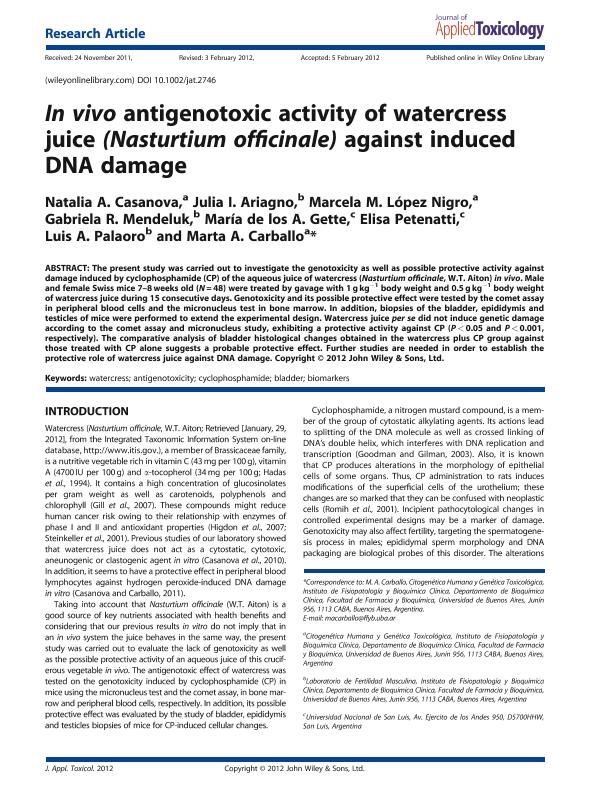Artículo
In vivo antigenotoxic activity of watercress juice (Nasturtium officinale) against induced DNA damage
Casanova, Natalia Andrea ; Ariagno, Julia Irene; López Nigro, Marcela Mabel; Mendeluk, Gabriela Ruth; Gette, Maria de Los Angeles
; Ariagno, Julia Irene; López Nigro, Marcela Mabel; Mendeluk, Gabriela Ruth; Gette, Maria de Los Angeles ; Petenatti, Elisa Margarita; Palaoro, Luis Alberto; Carballo, Marta Ana
; Petenatti, Elisa Margarita; Palaoro, Luis Alberto; Carballo, Marta Ana
 ; Ariagno, Julia Irene; López Nigro, Marcela Mabel; Mendeluk, Gabriela Ruth; Gette, Maria de Los Angeles
; Ariagno, Julia Irene; López Nigro, Marcela Mabel; Mendeluk, Gabriela Ruth; Gette, Maria de Los Angeles ; Petenatti, Elisa Margarita; Palaoro, Luis Alberto; Carballo, Marta Ana
; Petenatti, Elisa Margarita; Palaoro, Luis Alberto; Carballo, Marta Ana
Fecha de publicación:
09/2013
Editorial:
John Wiley & Sons Ltd
Revista:
Journal of Applied Toxicology
ISSN:
0260-437X
Idioma:
Inglés
Tipo de recurso:
Artículo publicado
Clasificación temática:
Resumen
The present study was carried out to investigate the genotoxicity as well as possible protective activity against damage induced by cyclophosphamide (CP) of the aqueous juice of watercress (Nasturtium officinale, W.T. Aiton) in vivo. Male and female Swiss mice 7-8 weeks old (N = 48) were treated by gavage with 1 g kg(-1) body weight and 0.5 g kg(-1) body weight of watercress juice during 15 consecutive days. Genotoxicity and its possible protective effect were tested by the comet assay in peripheral blood cells and the micronucleus test in bone marrow. In addition, biopsies of the bladder, epididymis and testicles of mice were performed to extend the experimental design. Watercress juice per se did not induce genetic damage according to the comet assay and micronucleus study, exhibiting a protective activity against CP (P < 0.05 and P < 0.001, respectively). The comparative analysis of bladder histological changes obtained in the watercress plus CP group against those treated with CP alone suggests a probable protective effect. Further studies are needed in order to establish the protective role of watercress juice against DNA damage.
Palabras clave:
antigenotoxicity
,
biomarkers
,
bladder
,
cyclophosphamide
Archivos asociados
Licencia
Identificadores
Colecciones
Articulos(OCA HOUSSAY)
Articulos de OFICINA DE COORDINACION ADMINISTRATIVA HOUSSAY
Articulos de OFICINA DE COORDINACION ADMINISTRATIVA HOUSSAY
Citación
Casanova, Natalia Andrea; Ariagno, Julia Irene; López Nigro, Marcela Mabel; Mendeluk, Gabriela Ruth; Gette, Maria de Los Angeles; et al.; In vivo antigenotoxic activity of watercress juice (Nasturtium officinale) against induced DNA damage; John Wiley & Sons Ltd; Journal of Applied Toxicology; 33; 9; 9-2013; 880-885
Compartir
Altmétricas



